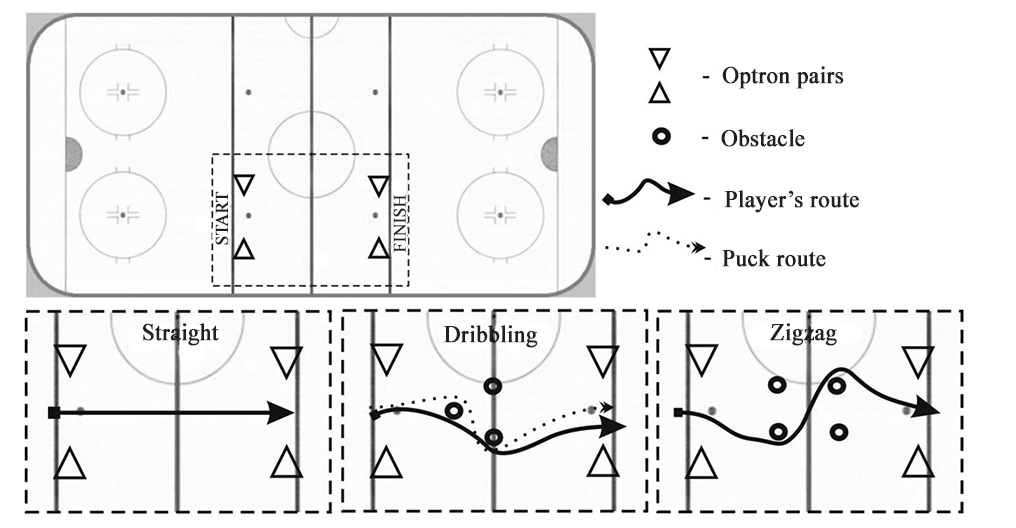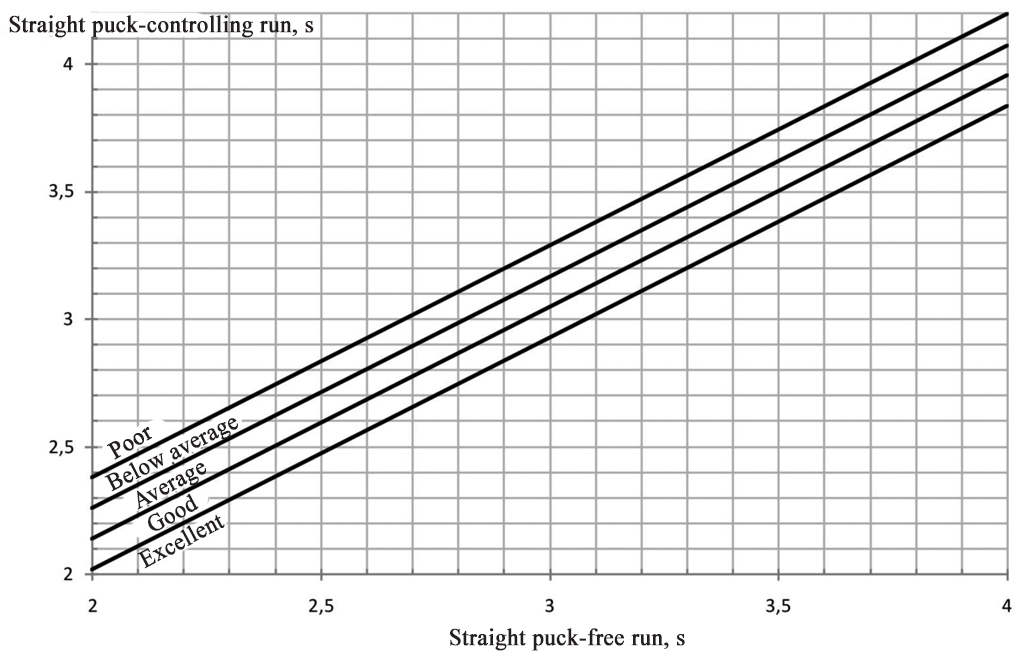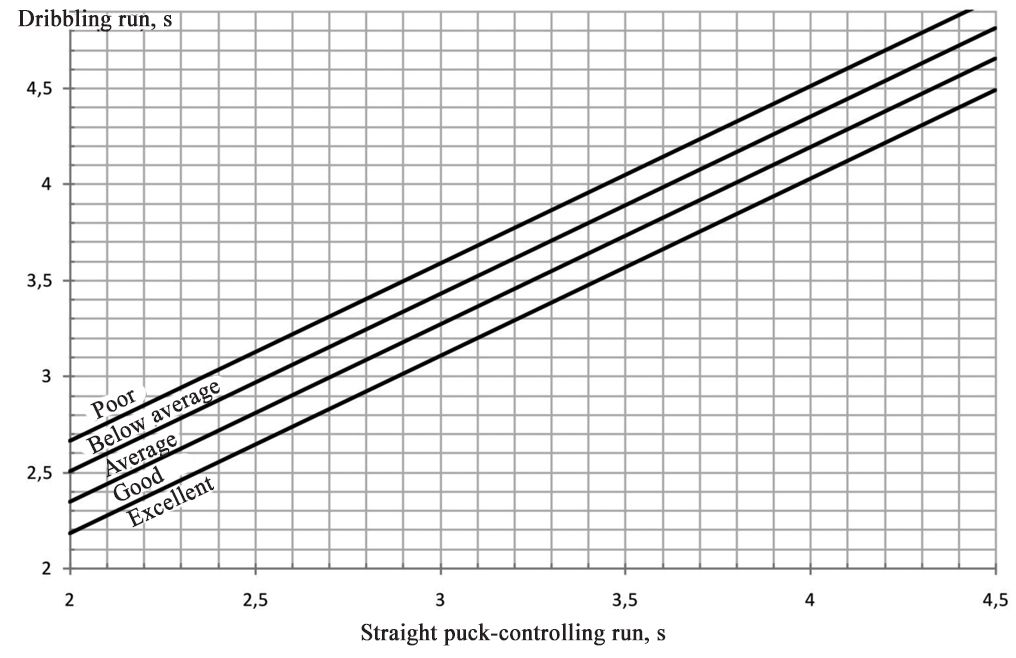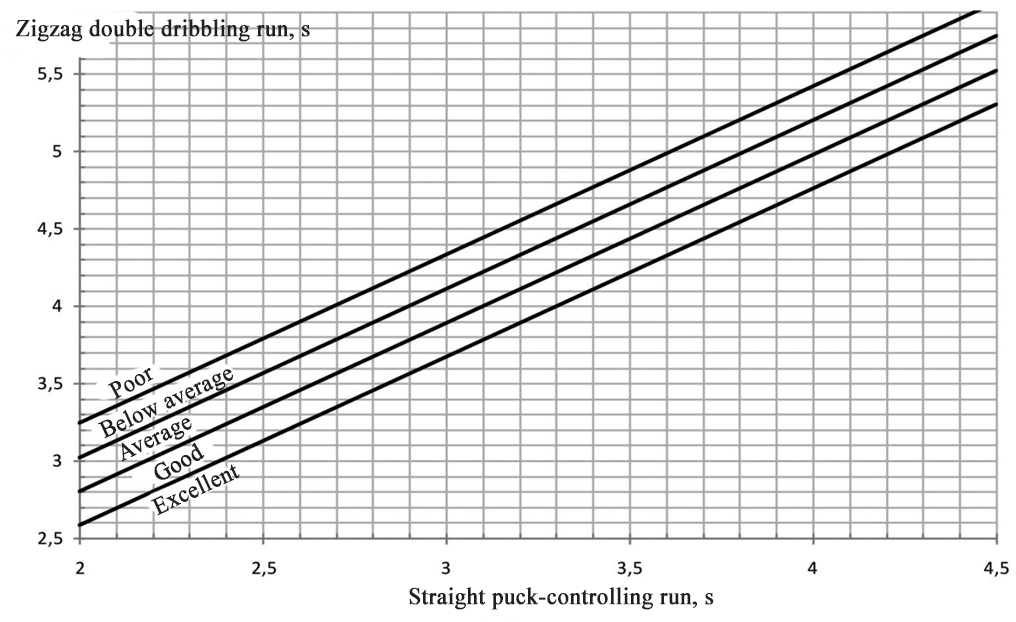Performance efficiency of puck-controlling manoeuvering skills in ice hockey
Фотографии:
ˑ:
Associate Professor A.P. Davydov1
PhD V.G. Medvedev1
1Russian State University of Physical Culture, Sport, Youth and Tourism (GTSOLIFK), Moscow
Keywords: technical fitness, puck control, dribbling, speed, technique rating, ice hockey skill tests, optron pairs.
Background. Initiatives to improve the athletes’ technical fitness levels are commonly known to be one of the most promising ways to step up competitive accomplishments [7, 8, 5, 3-5]. This is the reason why the studies of the ways to improve the athletic technique performance efficiency are viewed among the top priorities by the researchers of athletic movement sequences. Since ice hockey is a sport discipline that requires good coordination and perfect technical skills from the athletes, studies of a variety of motor actions and techniques have always been ranked among the most important ones.
An ice hockey player acting in different game situations strives to take such a position on the ice field as to facilitate the required motor actions. Tense competitive situations almost always require the puck-holding player move as soon as possible on the ice field keeping away from the opponents. The puck-controlling player’s manoeuvring speed will depend, on the one hand, on the individual motor potential of the player (i.e. his speed, speed-strength and other qualities) and, on the other hand, on how good he is in this potential employment, i.e. the execution techniques. Therefore, the ice hockey players’ technical skills should be rated with due consideration for the puck-control manoeuvring technique efficiency [1, 2, 6].
Objective of the study was to work out performance efficiency nomograms for the puck-controlling player’s manoeuvring skills in ice hockey.
Methods and structure of the study. Subject to the study were 59 ice hockey players (with body mass of 68.44±18.73 kg, body height 1.735±0.147 m and aged 15.7±3.75 years). The sample covered players of every game role (defenders, attackers and goalkeepers) and every skill level: from the primary training groups; basic education and training groups; and sport excellence groups. Tested under the study were the player’s speed in the straight puck-free skating, straight puck-controlled skating, dribbling and zigzag (double dribbling) skating tests. The tested players were required to perform the test task as fast as possible starting (in a free format) from the blue line. The puck was to be controlled within 2-2.5 m from the puck-controlling player (arm-with-the-stick length). The test completion time was fixed by the optron pairs of the MuscleLab Computerized System, the pairs being placed 16 m apart in the middle zone of the ice field (the range was 3 m wide, with the centre of the range in the middle point of the ice field). Given in Figure 1 hereunder are the optron pairs positions and test tasks. Obstacles (tyres) for the dribbling and zigzag double dribbling tests were placed so as to make a triangle (see Figure 1) with a 3 m base (on the central red line) and 2.6 m height; alternatively, they a square with a 3 m side placed symmetrically on the red line was formed.

Figure 1. Optron pairs positions on the ice field and the test tasks
Study results and discussion. The tests showed that the 16-m range was run by the puck-free player with a stick for 2.865±0.1884 s on average; whilst the puck-controlled run claimed 0.117 seconds more on average (p<0.05; puck-controlled run time is 2.982±0.2448 s). The dribbling was tested to claim on average 0.347 s more than the straight puck-controlled skating (p<0.05; dribbling skating time is 3.329±0.3114 s). The zigzag double dribbling was tested to claim 0.998 s more (p<0.05; zigzag double dribbling time is 3.980±0.4401 s). The test rates were found to be in statistically significant correlations, and this made it possible to apply a method of regression balances to work out the puck-controlling player’s manoeuvring, dribbling and zigzag run efficiency nomograms.
Regression equation for the straight puck-free skating (x) and straight puck-control skating (y) on the 16 m range (r=0.70, p<0.05) is the following: у = 0.3806 + 0.908∙х.
Regression equation for the straight puck-free skating (x) and dribbling skating (y) on the 16 m range (r=0.73, p<0.05) is the following: у = 0.5786 + 0.9224∙х.
Regression equation for the straight puck-control skating (x) and zigzag double dribbling skating (y) on the 16 m range (r=0.60, p<0.05) is the following: у = 0.7388 + 1.087∙х.
With account of the determination index (r2=0.49), the straight puck-control skating test result was found to be only half determined by the athlete’s physical abilities, but the test speed also heavily depends on the puck control technique. Given hereunder in Figures 2-4 see the puck-controlling player’s manoeuvring technique rating (equations-based) nomograms.

Figure 2. Straight-run puck-control technique efficiency rating nomogram

Figure 3. Dribbling-run puck-control technique efficiency rating nomogram

Figure 4. Zigzag double dribbling run puck-control technique efficiency rating nomogram
The above technique rates take into account the player’s motor abilities and show how good his performance in the individual potential employment is, i.e. the technique execution. The proposed method offers a set of nomograms to rate the players’ technical skills in the puck-control manoeuvring domain, and the method may be quite helpful for the coaches. Further studies of the manoeuvring technique in ice hockey may be complemented by expert analyses and advanced integrated approaches [8].
Conclusion. Success of the puck-controlling player’s manoeuvring skills is at least half dependent on the puck control technique and the dribbling/ zigzag double dribbling performance technique. The regression equations offered in the study for specific test tasks give the means to work out rating scales to rate efficiency of the puck-controlling player’s manoeuvring skills with account of the motor skills development levels.
References
- Medvedev V.G. Otsenka realizatsionnoy effektivnosti tekhniki bar'ernogo bega (Evaluation of realizable efficiency of hurdling technique) / V.G. Medvedev, E.V. Shelud'ko, An.A. Shalmanov // Biomekhanika dvigatel'nykh deystviy i biomekhanicheskiy kontrol' v sporte (Biomechanics of motor actions and biomechanical control in sport): Proc. of the III All-Rus. res.-pract. conf. with int. participation. – Malakhovka: MGAFK (MSAPC), 2015. – P. 58-64. – ISBN 978-5-00063-004-4.
- Medvedev V.G. Realizatsionnaya effektivnost' tekhniki pryzhkovykh uprazhneniy (Realizable efficiency of jumping exercise technique) / V.G. Medvedev, E.A. Lukunina, An.A. Shalmanov // «Sovremenny olimpiyskiy i paralimpiyskiy sport i sport dlya vsekh» (Modern Olympic and Paralympic sport and sport for all): Proc. of the 12-th Intern. scientific congress, May, 26-28, 2008 / RSUPCST (RGUFKSIT). – Moscow, 2008. – V. 2. – P. 118-119.
- Medvedev V.G. Eksperimental'naya proverka effektivnosti primeneniya integrativnogo podkhoda k izucheniyu dvigatel'nykh deystviy i otsenke tekhnicheskogo masterstva sportsmenov (Experimental verification of efficiency of integrative approach to study of motor actions and rate athletes' technical skills) / V.G. Medvedev, E.A. Lukunina, A.A. Shalmanov // Fizicheskaya kul'tura i obrazovanie, sport, biomekhanika, bezopasnost' zhiznedeyatel'nosti (Physical culture and education, sport, biomechanics, life safety): Proc. of Intern. scientific conf. Part II. / Ed. by Y.K. Koblev, E.G. Verzhbitskaya. – Maykop: AGU (ASU) pub. h-se, 2011. – P. 72-80.
- Shalmanov A. Metodologiya izucheniya i otsenki tekhnicheskogo masterstva (Methodology of study and evaluation of technical skills) / A. Shalmanov, Y. Lanka, V. Medvedev // Nauka v olimpiyskom sporte. – 2013. – # 3. – P. 65-72. – ISSN 1992-9315.
- Shalmanov A.A. Metody issledovaniya dvigatel'nykh deystviy i tekhnicheskogo masterstva sportsmenov v sportivnoy biomekhanike (Research methods of motor actions and technical skills of athletes in sports biomechanics) / A.A. Shalmanov, E.A. Lukunina, V.G. Medvedev // Sport Science: Encyclopaedia of Life Support Systems. – UNESCO pub., 2011. – P. 165-178. – ISBN 978-5-89317-226-3.
- Shalmanov An.A. Metodologicheskie aspekty biomekhaniki dvigatel'nykh deystviy (Methodological aspects of biomechanics of motor actions) / An.A. Shalmanov [et al.] // Athlete in interdisciplinary research: monograph / Ed. by M.P. Shestakov. – Moscow: TVT Divizion, 2009. – V. 4. – P. 260–299. – ISBN 978-5-98724-069-4.
- Hokelmann A. Biomekhanicheskie i elektromiograficheskie kharakteristiki tekhnicheskikh elementov v khudozhestvennoy gimnastike (Biomechanical and electromyographic characteristics of technical elements in rhythmic gymnastics) / A. Hokelmann, T. Lisitskaya, R. Fomin, L. Novikova, G. Liviott, D. Erdenko, K. Matychok, B. Tesch, V. Medvedev // Fitness 2010: Proc of International res.-pract. Internet-conference / RSUPCST (RGUFKSIT). - Moscow, 2010. - P. 69-70. – ISBN 978-5-904156-28-2.
- Lanka J. Integrative approach to the study and evaluation of technical preparedness in sports biomechanics / J. Lanka, A. Shalmanov, V. Medvedev // LASE Journal of Sport Science. – 2012. – Vol. 3. – Nr. 1. – pp. 3-21. – ISSN 1691-7669.
Corresponding author: biomechanics@bk.ru
Abstract
The study was designed to develop the performance efficiency nomograms to rate the puck-controlling player’s manoeuvring skills in ice hockey. Tested under the study were the player’s speed (straight puck-free skating, straight puck-controlled skating, dribbling and zigzag skating), the tests being performed using optron pairs of the MuscleLab Computerized System, the pairs being placed 16 m apart in the middle zone of the ice field. Test rates of 59 hockey players in the above tests were the following: 2.865 ± 0.1884; 2.982 ± 0.2448; 3.329 ± 0.3114 and 3.980 ± 0.4401 seconds, respectively. Mean and high correlations (p < 0.05) of the test rates made it possible to apply a method of regression balances to work out the puck-controlling player’s manoeuvring, dribbling and zigzag run efficiency rating nomograms.




